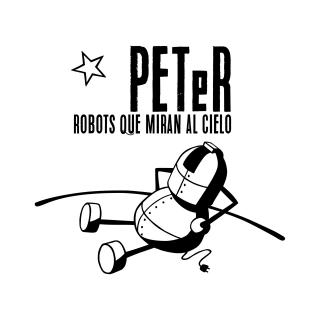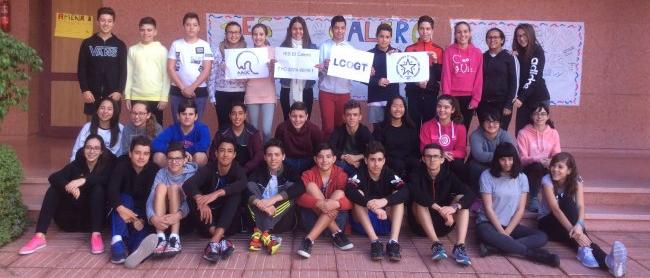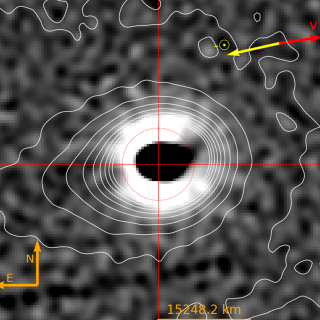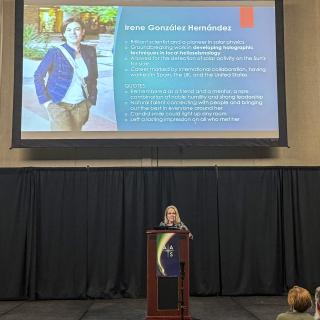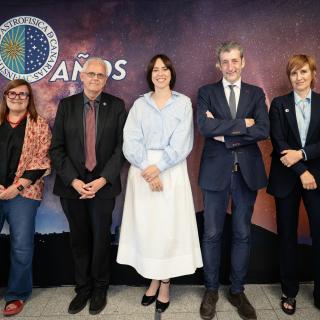Two groups in the second year of the ESO stage at the IES El Calero in Telde (Gran Canaria), together with their mathematics teacher, have discovered two new eclipsing binary systems, thanks to observations made with the CNL1 telescope at the Observatory of the Astronomical Group of Gran Canaria (AAGC for its initials in Spanish), two 40 cm telescopes belonging to the Las Cumbres Observatory Global Telescope (LCOGT) Network, one of them at the Teide Observatory (Tenerife) and the other in Hawaii, together with archive data. These students are the youngest in the world to make this achievement during formal education, although there are precedents of such findings by students of similar age in special camps for students with outstanding mathematical talents in various universities in the United States, or by private individuals.
The two systems discovered are towards the constellation of Andromeda and they are eclipsing contact binaries, pairs of stars which orbit around a common centre of mass, and which are so close together that they are effectively in contact, and share an outer layer of gas. In addition, the motions of these stars in their orbits occur in the same plane as that of the Earth, which is why we see the eclipses. As the stars are so close we see them as a single object, and what is observed are the variations in brightness of the system due to the eclipses. For that reason eclipsing binaries are counted among the variable stars.
The project, which has been named “My first discovery” was designed by Carlos Morales Socorro, a mathematics teacher at the IES El Calero, with the collaboration of the AAGC, of which he is a member. “In this project”, explains Carlos, “we have several aims: the student should learn and apply mathematical elements of different blocks of contents with the scheme of STEM (Science, Technology, Engineering and Maths), with the complete process oriented towards making a scientific discovery, and finally that they learn about a part of their heritage, by which I mean the sky, which unfortunately is not being safeguarded in the island of Gran Canaria”.
The experiment consisted of choosing several fields of observation, detecting the light from the stars in those fields during a long period using several telescopes, combining the observations which archive data from the Northern Sky Variability Survey (NSVS) catalogue, and analyzing the light curves obtained to see if there are any variable stars. Once a number of candidates were localized, the students determined what kinds of variables they are, estimated their periods, and made a mathematical characterization. The result was the discovery of two new variable stars, GSC 03224-01689 y TYC 3224-2619-1, both eclipsing contact binaries, with periods of 10.3 hours and 20.2 hours respectively.
The data were sent to the website International Variable Star Index (VSX) of the American Association of Variable Star Observers (AAVSO), which is the organization which collects, evaluates, and published observations of variable stars, keeping an international database, which is used by both professional and amateur astronomers. This association verified that the stars had not previously been catalogued as variables, recognized the discoveries, and granted certificates to the students and the teacher at the IES El Calero.
The idea to bring science closer to secondary school students using astronomy is also the basis of the Educational Project with Robotic Telescopes (Proyecto Educativo con Telescopios Robóticos (PETeR) of the IAC, of which the IES Calero is a member, and thanks to which they could make observations using the telescopes of the LCOGT network. “These students have made a genuine contribution to science”, points out Nayra Rodríguez Eugenio, the scientific coordinator of PETeR. “In this project we firmly believe that introducing science education in an attractive and practical way via real scientific projects in primary and secondary schools is fundamental for stimulating scientific and technological vocations, and to change the idea that subjects such as Maths or Physics are boring”.
In the same spirit, Ángel Luis Marrero Corujo, a member of the AAGC who has collaborated in the project comments, with respect to the discoverers, “Now they can say that they have something in common with Newton or with Galileo, which is that they have made contribution, albeit modest, to the increase in our knowledge of the universe around us”.
Links to the data on the AAVSO website for the stars which have been discovered:
Animation of a contact binary system https://youtu.be/mndNcAn2WRk Credit: ESO/L. Calçada.
Contact:
Carlos Morales Socorro (IES El Calero)
email: cmorsoc [at] gmail.com (cmorsoc[at]gmail[dot]com)
Twitter: @cmorsoc
